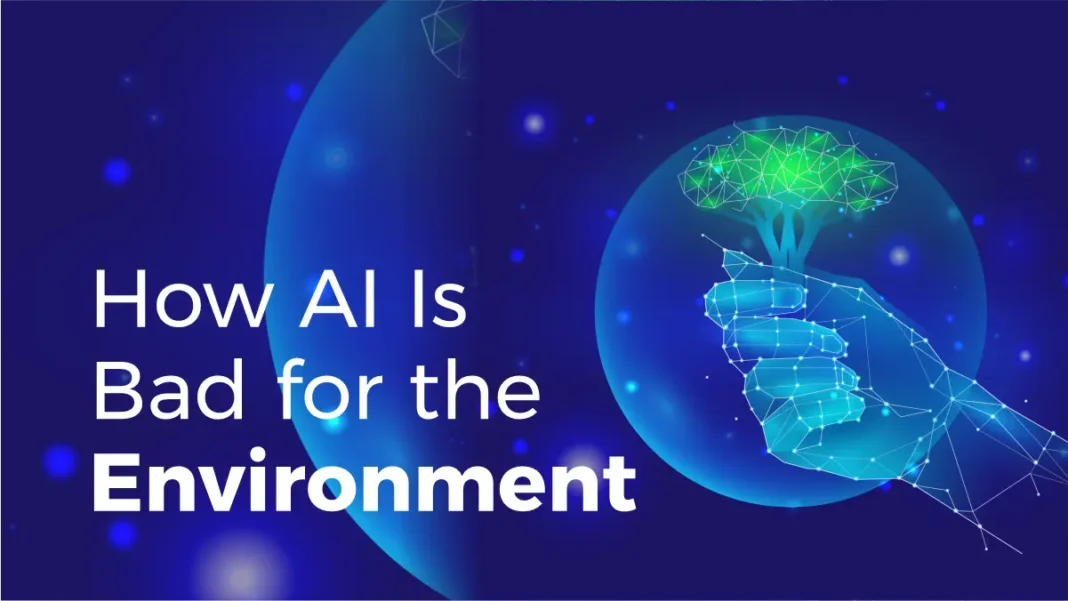How AI Is Bad for the Environment is not just a provocative headline – it’s an urgent reality. In the last few years, the meteoric rise of artificial intelligence has driven an unprecedented surge in computing power, resource consumption, and infrastructure expansion. From massive carbon emissions to water depletion, AI’s environmental footprint is quickly becoming impossible to ignore.
This article draws on 2024–2025 research to examine AI’s impact on the planet, covering energy, water, e-waste, pollution, and policy, while providing clear, actionable steps to reduce harm.
1. Energy Consumption & Carbon Footprint – How Does AI Negatively Affect the Environment?
The scale of AI’s energy demands is staggering:
- Carbon spike: Indirect emissions from major tech companies jumped ~150% from 2020 to 2023, largely due to AI growth. AI-related emissions could hit 102.6 million tCO₂e/year by 2026 (Reuters, 2025).
- High-energy queries: A single AI query can use 10× more electricity than a standard web search (Time, 2024).
- Data center boom: Global AI data center electricity demand could double by 2026, threatening grid stability (UNEP, 2024).
- Fossil reliance: Many new AI facilities run on gas-fired power plants, locking in long-term carbon output (FT, 2024).
2. Water Usage and Cooling – What Are the Negative Effects of AI?
Data centers that host AI models need constant cooling:
- A 100 MW AI data center can evaporate ~2 million liters/day – enough for 6,500 households (Wikipedia, 2024).
- By 2027, AI could consume 4.2–6.6 billion m³ of water annually – similar to the UK’s total yearly water use (Arxiv, 2024).
- Siting facilities in drought-prone regions like Arizona and Saudi Arabia worsens water scarcity (UNEP, 2024).
3. E-Waste & Resource Depletion
AI’s hunger for cutting-edge hardware shortens the lifecycle of electronics:
- By 2030, AI could add 1.2–5 million metric tons of e-waste – up to 12% of the global total (Wikipedia, 2024).
- Specialized chips require rare minerals like cobalt and neodymium, whose extraction often devastates ecosystems (UNEP, 2024).
4. Hidden and Indirect Impacts
a. Enabled Emissions
AI boosts fossil fuel extraction efficiency – a climate backslide not reflected in corporate carbon reports. Two Microsoft fossil fuel contracts alone caused emissions 3× greater than Microsoft’s own annual footprint (FT, 2024).
b. Public Health Costs
Operating AI data centers emits fine particulate pollution. Training a model like Llama3.1 can have a public health impact equivalent to 10,000 car trips; projected U.S. health costs exceed $20B/year by 2030 (Arxiv, 2024).
c. Environmental Justice
Polluting AI infrastructure often lands in marginalized communities, like the gas-turbine-powered AI hub in Memphis, which increased NO₂ levels by 79% (Time, 2025).
5. Case Studies & New Evidence
- Mistral’s Sustainability Tracker (2025): Large 2 model generated 20.4 ktCO₂e and used 281,000 m³ water; each 400-token prompt = 1.14 g CO₂e + 45 ml water (ITPro, 2025).
- Ireland’s power dilemma: AI centers consume 21% of the country’s electricity, halting new builds until 2028 (AP News, 2025).
- Policy rollback risks: U.S. fast-track plans for AI data centers could triple AI energy use by 2028 – equal to 1M+ Olympic pools of water (The Guardian, 2025).
6. How to Use AI Without Destroying the Environment
- Adopt efficient architectures: Use smaller, optimized models where possible.
- Track lifecycle impact: Follow Mistral’s example of transparent environmental reporting.
- Align with renewables: Build in regions with abundant green energy and invest in storage.
- Integrate carbon removal: Combine renewable power with carbon offset strategies.
- Push for regulation: Advocate for binding environmental disclosure in AI policy.
- Avoid environmental injustice: Don’t site polluting infrastructure in vulnerable areas.
- Practice conscious usage: Use local/on-device AI when possible, batch queries, and avoid unnecessary prompts.
Conclusion
AI’s environmental toll is real – spanning carbon emissions, water depletion, e-waste, pollution, and justice concerns. But harm is not inevitable.
“We need to make sure the net effect of AI on the planet is positive before we deploy the technology at scale.” – Sally Radwan, United Nations Environment Programme
Through efficiency, transparency, renewable integration, and equitable deployment, AI can shift from being a climate liability to a sustainability ally.
People Also Asked (FAQ)
Q1. How does AI negatively affect the environment?
By consuming massive amounts of energy, water, producing e-waste, enabling fossil fuel expansion, and generating pollution.
Q2. What are the negative effects of AI beyond carbon footprint?
It accelerates water scarcity, toxic e-waste, rare mineral mining, air pollution, and environmental injustice.
Q3. Does AI leave a carbon footprint?
Yes – training and running AI models produces measurable CO₂ emissions, even per prompt.
Q4. How to use AI without destroying the environment?
Choose efficient models, track impacts, use renewable-powered infrastructure, and reduce unnecessary AI usage.
Q5. Can AI help the environment while hurting it?
Yes, but only if its own environmental footprint is addressed alongside its potential benefits.


